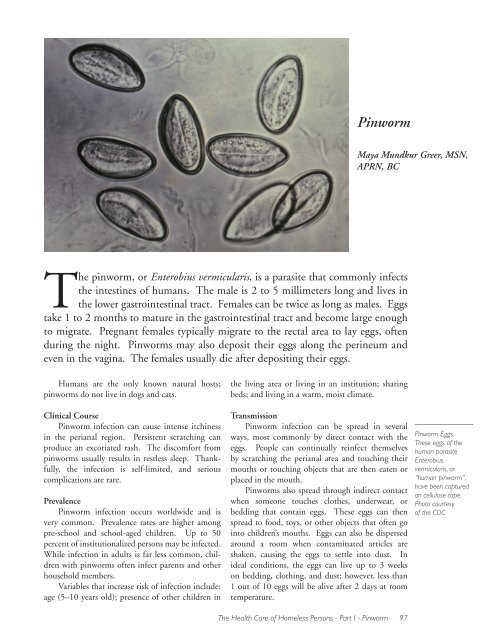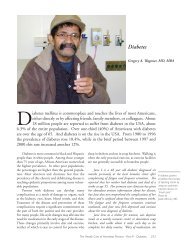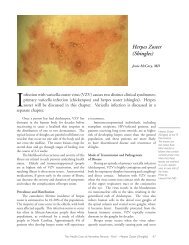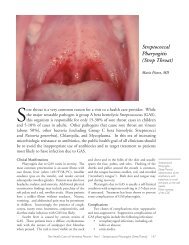Pinworm - Boston Health Care for the Homeless
Pinworm - Boston Health Care for the Homeless
Pinworm - Boston Health Care for the Homeless
You also want an ePaper? Increase the reach of your titles
YUMPU automatically turns print PDFs into web optimized ePapers that Google loves.
<strong>Pinworm</strong><br />
Maya Mundkur Greer, MSN,<br />
APRN, BC<br />
The pinworm, or Enterobius vermicularis, is a parasite that commonly infects<br />
<strong>the</strong> intestines of humans. The male is 2 to 5 millimeters long and lives in<br />
<strong>the</strong> lower gastrointestinal tract. Females can be twice as long as males. Eggs<br />
take 1 to 2 months to mature in <strong>the</strong> gastrointestinal tract and become large enough<br />
to migrate. Pregnant females typically migrate to <strong>the</strong> rectal area to lay eggs, often<br />
during <strong>the</strong> night. <strong>Pinworm</strong>s may also deposit <strong>the</strong>ir eggs along <strong>the</strong> perineum and<br />
even in <strong>the</strong> vagina. The females usually die after depositing <strong>the</strong>ir eggs.<br />
Humans are <strong>the</strong> only known natural hosts;<br />
pinworms do not live in dogs and cats.<br />
Clinical Course<br />
<strong>Pinworm</strong> infection can cause intense itchiness<br />
in <strong>the</strong> perianal region. Persistent scratching can<br />
produce an excoriated rash. The discom<strong>for</strong>t from<br />
pinworms usually results in restless sleep. Thankfully,<br />
<strong>the</strong> infection is self-limited, and serious<br />
complications are rare.<br />
Prevalence<br />
<strong>Pinworm</strong> infection occurs worldwide and is<br />
very common. Prevalence rates are higher among<br />
pre-school and school-aged children. Up to 50<br />
percent of institutionalized persons may be infected.<br />
While infection in adults is far less common, children<br />
with pinworms often infect parents and o<strong>the</strong>r<br />
household members.<br />
Variables that increase risk of infection include:<br />
age (5–10 years old); presence of o<strong>the</strong>r children in<br />
<strong>the</strong> living area or living in an institution; sharing<br />
beds; and living in a warm, moist climate.<br />
Transmission<br />
<strong>Pinworm</strong> infection can be spread in several<br />
ways, most commonly by direct contact with <strong>the</strong><br />
eggs. People can continually reinfect <strong>the</strong>mselves<br />
by scratching <strong>the</strong> perianal area and touching <strong>the</strong>ir<br />
mouths or touching objects that are <strong>the</strong>n eaten or<br />
placed in <strong>the</strong> mouth.<br />
<strong>Pinworm</strong>s also spread through indirect contact<br />
when someone touches clo<strong>the</strong>s, underwear, or<br />
bedding that contain eggs. These eggs can <strong>the</strong>n<br />
spread to food, toys, or o<strong>the</strong>r objects that often go<br />
into children’s mouths. Eggs can also be dispersed<br />
around a room when contaminated articles are<br />
shaken, causing <strong>the</strong> eggs to settle into dust. In<br />
ideal conditions, <strong>the</strong> eggs can live up to 3 weeks<br />
on bedding, clothing, and dust; however, less than<br />
1 out of 10 eggs will be alive after 2 days at room<br />
temperature.<br />
<strong>Pinworm</strong> Eggs.<br />
These eggs of <strong>the</strong><br />
human parasite<br />
Enterobius<br />
vermicularis, or<br />
“human pinworm”,<br />
have been captured<br />
on cellulose tape.<br />
Photo courtesy<br />
of <strong>the</strong> CDC<br />
The <strong>Health</strong> <strong>Care</strong> of <strong>Homeless</strong> Persons - Part I - <strong>Pinworm</strong> 97
A third mode of transmission is “retro-infection”.<br />
This happens when <strong>the</strong> pinworms reinfect<br />
<strong>the</strong> host by hatching in <strong>the</strong> perianal region and <strong>the</strong>n<br />
migrating back into <strong>the</strong> rectum.<br />
Diagnosis<br />
Perianal and perineal itching, especially at<br />
night, and a rash coupled with insomnia are <strong>the</strong><br />
most common complaints of pinworm infection.<br />
However, many pinworm infections are entirely<br />
without symptoms.<br />
The presence of pinworms can be confirmed<br />
in one of two ways. The first is direct observation<br />
of <strong>the</strong> adult worms around <strong>the</strong> anus, perineum, or<br />
entrance to <strong>the</strong> vagina. The optimum time to see <strong>the</strong><br />
worms is 1 to 2 hours after a child has gone to bed or<br />
on awakening in <strong>the</strong> morning. A flashlight will help<br />
with <strong>the</strong> search. A second test is to observe <strong>the</strong> eggs,<br />
which are about <strong>the</strong> size of <strong>the</strong> head of a pin, under<br />
a microscope. A 2-inch strip of scotch tape can be<br />
applied to <strong>the</strong> child’s perianal area in <strong>the</strong> morning<br />
be<strong>for</strong>e <strong>the</strong> child awakens. The tape may <strong>the</strong>n be<br />
transferred to a glass slide <strong>for</strong> examination.<br />
<strong>Pinworm</strong>s can be identified about 50% of <strong>the</strong><br />
time after a single attempt at one of <strong>the</strong>se tests.<br />
These tests should be repeated over 3 to 5 consecutive<br />
mornings be<strong>for</strong>e accepting a negative result.<br />
<strong>Pinworm</strong> infection usually runs in families, and a<br />
diagnosis in one person calls <strong>for</strong> <strong>the</strong> examination of<br />
all family and household members.<br />
Treatment<br />
Most people in single family households will get<br />
rid of pinworms without treatment. Un<strong>for</strong>tunately,<br />
larger group settings such as shelters and day care<br />
centers facilitate transmission and persistent infection.<br />
Breaking <strong>the</strong> cycle of reinfection through<br />
direct and indirect contact can be very difficult.<br />
Early treatment and thorough examination of<br />
family members and close friends will increase <strong>the</strong><br />
chances of eradication. If children in different<br />
families are diagnosed with pinworms within a<br />
short time, <strong>the</strong> entire shelter or day care facility may<br />
require treatment.<br />
Pyrantel pamoate (Antiminth) kills pinworms<br />
at dosages of 11 mg/kg to a maximum dose of 1<br />
gram. Antiminth can be used in people of all<br />
ages and is not contraindicated in pregnant women.<br />
Some people develop headaches and stomach pains<br />
when taking <strong>the</strong> drug, but <strong>the</strong>se side effects are<br />
uncommon. Antiminth is currently available<br />
without a prescription. Brand names include “Pin-<br />
X” and “Reese’s <strong>Pinworm</strong> Medication”.<br />
Mebendozole (Vermox) is an antihelminthic<br />
that comes in chewable tablets of 100 mg and has<br />
few side effects. Available by prescription, this<br />
medication is not recommended <strong>for</strong> pregnant<br />
women or children under two years of age.<br />
Albendazole (Albenza) is a pinworm medication<br />
available by prescription that is usually reserved<br />
<strong>for</strong> infections that are not cleared by <strong>the</strong> o<strong>the</strong>r<br />
preparations. A single 400 mg tablet is given by<br />
mouth. Once again, this medication is not recommended<br />
<strong>for</strong> pregnant women or children under <strong>the</strong><br />
age of two.<br />
Treatment with a second dose of medication<br />
(Vermox, Antiminth, or Albenza) 14 days<br />
after <strong>the</strong> first dose has a cure rate of 90 percent. In<br />
rare circumstances 4 to 6 treatments may be necessary<br />
to get rid of <strong>the</strong> infection.<br />
Vaseline and o<strong>the</strong>r over <strong>the</strong> counter creams<br />
or ointments can help relieve <strong>the</strong> itching caused by<br />
pinworms when applied to <strong>the</strong> perianal area.<br />
Prevention and Control<br />
The control of pinworms calls <strong>for</strong> personal and<br />
environmental hygiene. Staff must be particularly<br />
sensitive to an individual’s feelings of guilt or<br />
embarrassment. <strong>Pinworm</strong>s can infect <strong>the</strong> cleanest<br />
household. When discussing hygiene, staff should<br />
emphasize <strong>the</strong> ease of transmission and frequency of<br />
reinfection. <strong>Pinworm</strong>s can spread easily to a whole<br />
family and throughout an entire family shelter<br />
unless <strong>the</strong> source is treated.<br />
During treatment <strong>for</strong> pinworms, <strong>the</strong> linens,<br />
bedclo<strong>the</strong>s, underwear, and toys of infected<br />
individuals should be washed in hot (131°F/55°C)<br />
soapy water. If washing is not possible, <strong>the</strong>n <strong>the</strong><br />
articles should be thoroughly vacuumed. Be<strong>for</strong>e<br />
cleaning, you can avoid dispersing <strong>the</strong> eggs into <strong>the</strong><br />
air by handling every article with minimal shaking.<br />
Staff and guests should damp dust, damp mop,<br />
and/or vacuum <strong>the</strong> living space of infected guests<br />
and common rooms daily <strong>for</strong> several days after<br />
treatment to reduce <strong>the</strong> number of eggs that may<br />
reside in dust.<br />
If <strong>the</strong> entire shelter needs treatment, all linens,<br />
bedclo<strong>the</strong>s, and living space should be considered<br />
infected. Guests and staff should clean all articles<br />
and spaces as described above.<br />
The following measures also help to reduce<br />
transmission:<br />
• discourage scratching in <strong>the</strong> anal area;<br />
• <strong>the</strong> use of gloves and close fitting bed<br />
clo<strong>the</strong>s can be helpful;<br />
• trim nails to minimize biting;<br />
98 The <strong>Health</strong> <strong>Care</strong> of <strong>Homeless</strong> Persons - Part I - <strong>Pinworm</strong>
• wash hands with warm, soapy water be<strong>for</strong>e<br />
preparing, serving, or eating food and after<br />
using <strong>the</strong> toilet or changing diapers.<br />
• avoid shaking or fanning <strong>the</strong> bedding.<br />
Summary<br />
<strong>Pinworm</strong>s are tiny worms that live in a person’s<br />
intestines. Female pinworms crawl to <strong>the</strong> rectal area<br />
at night to lay eggs, causing <strong>the</strong> infected person to<br />
itch and to sleep restlessly. While uncom<strong>for</strong>table,<br />
pinworms rarely cause serious complications.<br />
However, <strong>the</strong>y are easily spread among people who<br />
live or play closely toge<strong>the</strong>r, particularly children.<br />
When a child scratches, <strong>the</strong> eggs of pinworms can<br />
get on <strong>the</strong> hands and under <strong>the</strong> fingernails. The<br />
child can <strong>the</strong>n put his or her hands into <strong>the</strong> mouth<br />
or onto objects such as toys or food. The eggs are<br />
also easily spread around a room when infected<br />
linen or clothing is shaken.<br />
When one person in a family is found to have<br />
pinworms, <strong>the</strong> entire family needs to be examined.<br />
When <strong>the</strong> infected person and close contacts are<br />
treated early, <strong>the</strong>re is little risk to <strong>the</strong> rest of <strong>the</strong><br />
shelter. If several cases happen in different families,<br />
<strong>the</strong> entire shelter may need treatment.<br />
<strong>Pinworm</strong>s reappear easily, but careful hygiene<br />
reduces <strong>the</strong> prospect of reinfection during treatment.<br />
You should consult <strong>the</strong> local board of<br />
health and caregivers <strong>for</strong> specific control measures<br />
regarding this infection. E<br />
<strong>Pinworm</strong> Medication List<br />
Generic Brand Name Cost<br />
albendazole Albenza $$$<br />
mebendazole Vermox $<br />
pyrantel pamoate<br />
Antiminth (Pin-X, Reese’s <strong>Pinworm</strong><br />
Medication)<br />
$<br />
References<br />
<strong>Pinworm</strong> infection. In: Pickering LK, et al., eds. 2000 Red Book: Report of <strong>the</strong> Committee on Infectious Disease. Elk<br />
Grove Village, IL: American Academy of Pediatrics; 2000:449-451.<br />
Bundy DAP, et al. Nematodes limited to <strong>the</strong> intestinal tract (Enterobius vermicularis, Trichuris trichuira, and<br />
Capillaria phillippinensis). In: Strickland GT, ed. Hunter’s Tropical Medicine and Emerging Infectious Diseases.<br />
Philadelphia: WB Saunders; 2000:719-726.<br />
Drugs <strong>for</strong> parasitic infection. Medical Letter on Drugs and Therapeutics 1998;40(1017):1-12.<br />
Enterobiasis (<strong>Pinworm</strong> disease). In: Benenson AS, ed. Control of Communicable Disease in Man. Washington D.C.:<br />
American Public <strong>Health</strong> Association; 1990:157-159.<br />
Hearns VL. <strong>Pinworm</strong>s. In: Rakel RE, ed. Saunders Manual of Medical Practice. Philadelphia: W.B. Saunders; 2000.<br />
Nelson JD, Bradley JS. Nelson’s Pocket Book of Pediatric Antimicrobial Treatment. Lippincott Williams and Wilkins;<br />
2000.<br />
<strong>Pinworm</strong> infestation. In: Berkow R, ed. The Merck Manual. Rahway, New Jersey: Merck and Company; 2000:<br />
2363-2364.<br />
Owen RL. Parasitic diseases. In: Sleisenger MH, Fordtran JS, eds. Gastrointestinal Disease: Pathophysiology, Diagnosis,<br />
and Management. Philadelphia: W.B. Saunders Company; 1989.<br />
Urbach AH. <strong>Pinworm</strong>s. In: Burg FD, et al., eds. Gellis and Kagan’s Current Pediatric Therapy. Philadelphia: WB<br />
Saunders Company; 1999.<br />
The <strong>Health</strong> <strong>Care</strong> of <strong>Homeless</strong> Persons - Part I - <strong>Pinworm</strong> 99







